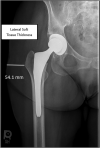Predictive value of lateral soft tissue thickness for complications after total hip arthroplasty with a lateral incision
- PMID: 32675949
- PMCID: PMC7340420
- DOI: 10.1080/08998280.2020.1753455
Predictive value of lateral soft tissue thickness for complications after total hip arthroplasty with a lateral incision
Abstract
The purpose of this study was to determine the relationship between soft tissue thickness lateral to the greater trochanter, as measured on anteroposterior pelvis radiograph, and postoperative complications following primary total hip arthroplasty. A retrospective review of 1110 consecutive patients treated at a single institution from 2003 to 2011 was conducted. Postoperative complications were divided into surgical site infections, deep wound infections, noninfectious surgical complications, need for revision surgery, and medical complications. Lateral soft tissue thickness (LSTT) was measured as the horizontal distance from the most lateral point on the greater trochanter to the skin edge obtained from anteroposterior hip radiographs. Among the 1110 study patients, 19.19% had a postoperative complication, with a deep infection rate of 3.42%. Of the previously identified risk factors, increased LSTT and body mass index were both associated with surgical site infection and deep infection, and LSTT was associated with revision surgery. An LSTT value of >5 cm was predictive of surgical site infection, deep infection, and revision surgery. This easily obtainable radiographic measurement, along with clinical examination near the operative site, might prove helpful in making preoperative risk assessments.
Keywords: Lateral soft tissue thickness; surgical site infections; total hip arthroplasty.
Copyright © 2020 Baylor University Medical Center.
Figures
References
LinkOut - more resources
Full Text Sources


